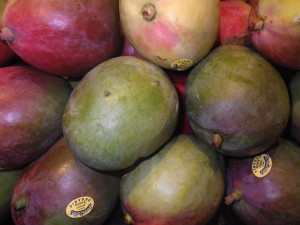 After the discussion on mangos being the most consumed fruit in the world I realized I didn’t know as much about this fruit as I thought. So I did some additional research.
After the discussion on mangos being the most consumed fruit in the world I realized I didn’t know as much about this fruit as I thought. So I did some additional research.
While it might be the most eaten fruit in the world, it’s still far down the popularity list in the United States. According to a 2012 study by Fresh Facts Shopper Insights found at www.mango.org mangos are only purchased by 14% of the households in the US. To compare this with other fruits: bananas have an 85% market penetration and apples 71%. When looking at “mainstream fruits” purchased, mangos fall below bananas, apples and grapes but above pineapples, kiwi and papaya. Mango buyers typically purchase them 2-3 times per year. The strongest buyers are “foodies”, natural/organic shoppers and Hispanic shoppers.
Mangos grow in frost free climates which is why Hawaii, Florida and California are the only states in which they grow. They must have warm dry weather to produce fruit.They are native to Southeast Asia and are considered a staple in India, China and the Philippines. Mangos have two seasons and different varieties are available at different times of the year so they are available year round. Mexico is one of the biggest suppliers of mangos to the US along with Haiti, Guatemala, Ecuador, Peru and Brazil.
The size and shape of a mango differs based on variety. They can range in size from 6 -24 ounces. It is said that mangos with the best flavor are those that are allowed to ripen on the tree. But unless you have a tree in your backyard this is going to be difficult.
The leathery skin of a mango is waxy and smooth. When ripe it can be pale green to golden yellow or orange marked with red. But color is not the best indicator of ripeness. Mangos continue to ripen off the tree if kept at room temperature. A ripe mango will give slightly and become softer as they ripen. When ripe the fruit will feel similar to a ripe peach or an avocado. To speed ripening place them in a paper bag. Ripe mangos can be refrigerated, but should be used within several days. Once cut they will keep in an airtight container for a few days or up to six months in the freezer.
The flesh of a mango is peach-like, juicy and in my opinion luscious. The large oval-flat husky stone/seed makes it difficult to cut or use. One of the best ways to cut a mango is to cut the fruit lengthwise just along the outside of the seed. This gives you two large portions of seedless fruit. I usually work to get a few more bites off the top and bottom of the seed. There is frequently inedible fiber close to the stone/seed. A high-quality mango will have minimal fiber, this is mostly due to the variety/cultivar and difficult to tell when selecting.
Mangos are fat, sodium and cholesterol free. Nutritionally, one cup (165 grams-about 6 ounces) of mango chunks contains 100 calories and 3 grams of fiber, 35% of the RDA for Vitamin A, 100% RDA for Vitamin C and 20% RDA of folate. Mangos also contain copper, Vitamin K and Potassium.
I’m now on a personal crusade to increase the consumption of mangos in the US. We’ve had them at least five times this year and I vow it’s going to be more. Here’s a great way…make your own mango salsa http://www.foodandhealth.com/recipes.php?id=482 Try it on fish!
Cheryle Jones Syracuse, MS
Professor Emeritus, The Ohio State University